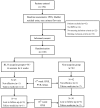Electroacupuncture for moderate and severe benign prostatic hyperplasia: a randomized controlled trial
- PMID: 23593139
- PMCID: PMC3625218
- DOI: 10.1371/journal.pone.0059449
Electroacupuncture for moderate and severe benign prostatic hyperplasia: a randomized controlled trial
Abstract
Purpose: To evaluate the effects of electroacupuncture (EA) on the International Prostate Symptom Score (IPSS), postvoid residual urine (PVR), and maximum urinary flow rate (Qmax), and explore the difference between EA at acupoints and non-acupoints in patients with moderate to severe benign prostate hyperplasia (BPH).
Subjects and methods: Men with BPH and IPSS ≥8 were enrolled. Participants were randomly allocated to receive EA at acupoint (treatment group, n = 50) and EA at non-acupoint (control group, n = 50). The primary outcome measure includes the change of IPSS at the 6th week and the secondary outcome measures include changes of PVR and Qmax at the 6th week and change of IPSS at the 18th week.
Results: 100/192 patients were included. At the 6th week, treatment group patients had a 4.51 (p<0.001) and 4.12 (p<0.001) points greater decline in IPSS than the control group in the intention to treat (ITT) and per-protocol (PP) populations. At the 18th week, a 3.2 points (p = 0.001) greater decline was found in IPSS for the treatment. No significant differences were found between the two groups in Qmax at the 6th week (p = 0.819). No significant difference was observed in PVR (P = 0.35).
Conclusion: Acupoint EA at BL 33 had better effects on IPSS, but no difference on PVR and Qmax as compared with non-acupoint EA. The results indicate that EA is effective in improving patient's quality of life and acupoint may have better therapeutic effects than non-acupoints in acupuncture treatments of BPH.
Trial registration: ClinicalTrials.gov NCT01218243.
Conflict of interest statement
Figures
Similar articles
-
Effectiveness and safety of electroacupuncture and its cotreatment with electronic moxibustion in the treatment of patients with moderate benign prostatic hyperplasia using alpha blocker: Study protocol for an assessor-blinded, randomized controlled clinical trial.Medicine (Baltimore). 2020 Apr;99(15):e19678. doi: 10.1097/MD.0000000000019678. Medicine (Baltimore). 2020. PMID: 32282720 Free PMC article. Clinical Trial.
-
[Efficacy of electroacupuncture in treating 93 patients with benign prostatic hyperplasia].Zhongguo Zhong Xi Yi Jie He Za Zhi. 2008 Nov;28(11):998-1000. Zhongguo Zhong Xi Yi Jie He Za Zhi. 2008. PMID: 19213342 Clinical Trial. Chinese.
-
Effect of Depth of Electroacupuncture on the IPSS of Patients with Benign Prostatic Hyperplasia.Evid Based Complement Alternat Med. 2019 Dec 12;2019:1439141. doi: 10.1155/2019/1439141. eCollection 2019. Evid Based Complement Alternat Med. 2019. PMID: 31915442 Free PMC article.
-
Prostate artery embolisation for benign prostatic hyperplasia: a systematic review and meta-analysis.Eur Radiol. 2019 Jan;29(1):287-298. doi: 10.1007/s00330-018-5564-2. Epub 2018 Jun 14. Eur Radiol. 2019. PMID: 29948079
-
Comparison of photoselective green light laser vaporisation versus traditional transurethral resection for benign prostate hyperplasia: an updated systematic review and meta-analysis of randomised controlled trials and prospective studies.BMJ Open. 2019 Aug 21;9(8):e028855. doi: 10.1136/bmjopen-2018-028855. BMJ Open. 2019. PMID: 31439603 Free PMC article.
Cited by
-
Efficacy of acupuncture for chronic prostatitis/chronic pelvic pain syndromes: study protocol for a randomized, sham acupuncture-controlled trial.BMC Complement Altern Med. 2016 Nov 7;16(1):440. doi: 10.1186/s12906-016-1428-y. BMC Complement Altern Med. 2016. PMID: 27821109 Free PMC article. Clinical Trial.
-
Complementary therapies in the control of male lower urinary tract symptoms: A systematic review.Rev Lat Am Enfermagem. 2022 Jul 15;30:e3597. doi: 10.1590/1518-8345.5897.3597. eCollection 2022. Rev Lat Am Enfermagem. 2022. PMID: 35858004 Free PMC article.
-
The Role of Acupuncture in Pain Management.Curr Pain Headache Rep. 2016 Apr;20(4):22. doi: 10.1007/s11916-016-0552-1. Curr Pain Headache Rep. 2016. PMID: 26896946 Review.
-
Acupuncture for benign prostatic hyperplasia in the elderly: A systematic review of acupoints.Medicine (Baltimore). 2025 Aug 8;104(32):e43802. doi: 10.1097/MD.0000000000043802. Medicine (Baltimore). 2025. PMID: 40797416 Free PMC article.
-
Effectiveness and safety of electroacupuncture and its cotreatment with electronic moxibustion in the treatment of patients with moderate benign prostatic hyperplasia using alpha blocker: Study protocol for an assessor-blinded, randomized controlled clinical trial.Medicine (Baltimore). 2020 Apr;99(15):e19678. doi: 10.1097/MD.0000000000019678. Medicine (Baltimore). 2020. PMID: 32282720 Free PMC article. Clinical Trial.
References
-
- Nickel JC (2006) The overlapping lower urinary tract symptoms of benign prostatic hyperplasia and prostatitis. CurrOpinUrol 16: 5–10. - PubMed
-
- Hong SK, Lee ST, Jeong SJ, Byun SS, Hong YK, et al. (2010) Chronic kidney disease among men with lower urinary tract symptoms due to benign prostatic hyperplasia. BJU Int 105(10): 1424–8. - PubMed
-
- American Urology Association (2012) Guideline on the Management of Benign Prostatic Hyperplasia. http://www.auanet.org/content/guidelines-and-quality-care/clinical-guide.... pdf (accessed 1/31/2013).
Publication types
MeSH terms
Associated data
LinkOut - more resources
Full Text Sources
Other Literature Sources
Medical
Research Materials
Miscellaneous



